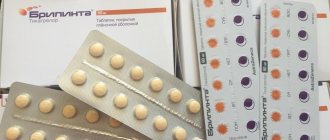Clopidogrel-SZ, 75 mg, film-coated tablets, 30 pcs.
Pharmacotherapeutic group: antiplatelet agent.
ATX code: [B01AC04]
PHARMACOLOGICAL PROPERTIES
Pharmacodynamics
Clopidogrel is a prodrug, one of the active metabolites of which is an inhibitor of platelet aggregation. The active metabolite of clopidogrel selectively inhibits the binding of adenosine diphosphate (ADP) to the P2Y12 platelet receptor and subsequent ADP-mediated activation of the GPIIb/IIIa complex, leading to suppression of platelet aggregation. Due to irreversible binding, platelets remain immune to ADP stimulation for the remainder of their life (approximately 7-10 days), and restoration of normal platelet function occurs at a rate consistent with platelet turnover. Platelet aggregation induced by agonists other than ADP is also inhibited by blocking enhanced platelet activation by released ADP. Since the formation of the active metabolite occurs with the help of isoenzymes of the P450 system, some of which may differ in polymorphism or may be inhibited by other drugs, adequate platelet suppression is not possible in all patients. Clopidogrel is able to prevent the development of atherothrombosis in any localization of atherosclerotic vascular lesions, in particular in lesions of the cerebral, coronary or peripheral arteries.
When taking clopidogrel daily at a dose of 75 mg, from the first day of administration there is a significant suppression of ADP-induced platelet aggregation, which gradually increases over 3-7 days and then reaches a constant level (when an equilibrium state is reached). At steady state, platelet aggregation is suppressed by an average of 40-60%. After discontinuation of clopidogrel, platelet aggregation and bleeding time gradually returned to baseline levels within an average of 5 days.
Pharmacokinetics
Suction
When administered orally at a dose of 75 mg per day, clopidogrel is rapidly absorbed. Average maximum plasma concentrations of unchanged clopidogrel (approximately 2.2-2.5 ng/ml after oral administration of a single 75 mg dose) are achieved approximately 45 minutes after administration. According to the excretion of clopidogrel metabolites by the kidneys, its absorption is approximately 50%.
Distribution
In vitro, clopidogrel and its main inactive metabolite circulating in the blood are reversibly bound to plasma proteins (98% and 94%, respectively) and this binding is unsaturated up to a concentration of 100 mg/l.
Metabolism
Clopidogrel is extensively metabolized in the liver. In vitro and in vivo, clopidogrel is metabolized in two ways: the first - through enzymes and subsequent hydrolysis with the formation of an inactive carboxylic acid derivative (85% of circulating metabolites), and the second way - through the cytochrome P450 system. Initially, clopidogrel is metabolized to 2-oxo-clopidogrel, which is an intermediate metabolite. Subsequent metabolism of 2-oxo-clopidogrel leads to the formation of the active metabolite of clopidogrel, a thiol derivative of clopidogrel. In vitro, this metabolic pathway occurs through the isoenzymes CYP2CI9, CYP1A2 and CYP2B6. The active thiol metabolite of clopidogrel, which was isolated in in vitro studies, rapidly and irreversibly binds to platelet receptors, thereby blocking platelet aggregation.
Removal
Within 120 hours after human ingestion of 14C-labeled clopidogrel, approximately 50% of the radioactivity is excreted by the kidneys and approximately 46% of the radioactivity is excreted through the intestines. After a single oral dose of 75 mg, the half-life of clopidogrel is approximately 6 hours. After a single dose and repeated doses, the half-life of the main inactive metabolite circulating in the blood is 8 hours.
Pharmacogenetics
With the help of the CYP2C19 isoenzyme, both the active metabolite and the intermediate metabolite, 2-oxo-clopidogrel, are formed. The pharmacokinetics and antiplatelet effect of the active metabolite of clopidogrel, when studying ex vivo platelet aggregation, vary depending on the genotype of the CYP2C19 isoenzyme. The allele of the CYP2C19*1 gene corresponds to a fully functional metabolism, while the alleles of the CYP2C19*2 and CYP2C19*3 genes are non-functional. Alleles of the CYP2C19*2 and CYP2C19*3 genes are the cause of decreased metabolism in the majority of representatives of the Caucasian (85%) and Mongoloid races (99%). Other alleles associated with absent or decreased metabolism are less common and include, but are not limited to, the CYP2C19*4, *5, *6, *7, and *8 alleles. Patients with low CYP2C19 activity must have the two loss-of-function alleles listed above. Published frequencies of occurrence of phenotypes in individuals with low CYP2C19 activity are 2% in Caucasians, 4% in Blacks, and 14% in Chinese. To determine the patient's genotype of the CYP2C19 isoenzyme, there are appropriate tests. Based on a cross-sectional study (40 volunteers) and a meta-analysis of six studies (335 volunteers). Which included subjects with very high, high, intermediate and low activity of the CYP2C19 isoenzyme, any significant differences in the exposure of the active metabolite and in the mean values of inhibition of platelet aggregation (IAT) (induced by ADP) in volunteers with very high, high and intermediate activity the CYP2C19 isoenzyme was not detected. In volunteers with low CYP2C19 isoenzyme activity, exposure to the active metabolite was reduced compared to volunteers with high CYP2C19 isoenzyme activity. When volunteers with low CYP2C19 activity received the 600 mg loading dose/150 mg maintenance dose regimen (600 mg/150 mg), exposure to the active metabolite was higher than when taking the 300 mg/75 mg regimen. In addition, IAT was similar to that in groups of patients with higher rates of metabolism by the isoenzyme CYP2C19 receiving the 300 mg/75 mg treatment regimen. However, in studies taking into account clinical outcomes, the dosage regimen of clopidogrel for patients in this group (patients with low CYP2C19 isoenzyme activity) has not yet been established. Clinical studies to date have not had a sufficient sample size to detect differences in clinical outcome in patients with low CYP2C19 activity.
Selected patient groups
The pharmacokinetics of the active metabolite of clopidogrel in elderly patients, children, and patients with kidney and liver diseases has not been studied.
Clopidogrel tab 75 mg N90 (Northern Star)
Pharmacotherapeutic group: antiplatelet agent. ATC code: [B01AC04] PHARMACOLOGICAL PROPERTIES Pharmacodynamics Clopidogrel is a prodrug, one of the active metabolites of which is an inhibitor of platelet aggregation. The active metabolite of clopidogrel selectively inhibits the binding of adenosine diphosphate (ADP) to the P2Y12 platelet receptor and subsequent ADP-mediated activation of the GPIIb/IIIa complex, leading to suppression of platelet aggregation. Due to irreversible binding, platelets remain immune to ADP stimulation for the remainder of their life (approximately 7-10 days), and restoration of normal platelet function occurs at a rate consistent with platelet turnover. Platelet aggregation induced by agonists other than ADP is also inhibited by blocking enhanced platelet activation by released ADP. Since the formation of the active metabolite occurs with the help of isoenzymes of the P450 system, some of which may differ in polymorphism or may be inhibited by other drugs, adequate platelet suppression is not possible in all patients. Clopidogrel is able to prevent the development of atherothrombosis in any localization of atherosclerotic vascular lesions, in particular in lesions of the cerebral, coronary or peripheral arteries. When taking clopidogrel daily at a dose of 75 mg, from the first day of administration there is a significant suppression of ADP-induced platelet aggregation, which gradually increases over 3-7 days and then reaches a constant level (when an equilibrium state is reached). At steady state, platelet aggregation is suppressed by an average of 40-60%. After discontinuation of clopidogrel, platelet aggregation and bleeding time gradually returned to baseline levels within an average of 5 days. Pharmacokinetics Absorption When taken orally at a dose of 75 mg per day, clopidogrel is rapidly absorbed. Average maximum plasma concentrations of unchanged clopidogrel (approximately 2.2-2.5 ng/ml after oral administration of a single 75 mg dose) are achieved approximately 45 minutes after administration. According to the excretion of clopidogrel metabolites by the kidneys, its absorption is approximately 50%. Distribution In vitro, clopidogrel and its main inactive metabolite circulating in the blood are reversibly bound to plasma proteins (98% and 94%, respectively) and this bond is unsaturated up to a concentration of 100 mg/l. Metabolism Clopidogrel is extensively metabolized in the liver. In vitro and in vivo, clopidogrel is metabolized in two ways: the first - through enzymes and subsequent hydrolysis with the formation of an inactive carboxylic acid derivative (85% of circulating metabolites), and the second way - through the cytochrome P450 system. Initially, clopidogrel is metabolized to 2-oxo-clopidogrel, which is an intermediate metabolite. Subsequent metabolism of 2-oxo-clopidogrel leads to the formation of the active metabolite of clopidogrel, a thiol derivative of clopidogrel. In vitro, this metabolic pathway occurs through the isoenzymes CYP2CI9, CYP1A2 and CYP2B6. The active thiol metabolite of clopidogrel, which was isolated in in vitro studies, rapidly and irreversibly binds to platelet receptors, thereby blocking platelet aggregation. Excretion Within 120 hours after human ingestion of 14C-labeled clopidogrel, approximately 50% of the radioactivity is excreted by the kidneys and approximately 46% of the radioactivity is excreted through the intestines. After a single oral dose of 75 mg, the half-life of clopidogrel is approximately 6 hours. After a single dose and repeated doses, the half-life of the main inactive metabolite circulating in the blood is 8 hours. Pharmacogenetics With the help of the CYP2C19 isoenzyme, both the active metabolite and the intermediate metabolite, 2-oxo-clopidogrel, are formed. The pharmacokinetics and antiplatelet effect of the active metabolite of clopidogrel, when studying ex vivo platelet aggregation, vary depending on the genotype of the CYP2C19 isoenzyme. The allele of the CYP2C19*1 gene corresponds to a fully functional metabolism, while the alleles of the CYP2C19*2 and CYP2C19*3 genes are non-functional. Alleles of the CYP2C19*2 and CYP2C19*3 genes are the cause of decreased metabolism in the majority of representatives of the Caucasian (85%) and Mongoloid races (99%). Other alleles associated with absent or decreased metabolism are less common and include, but are not limited to, the CYP2C19*4, *5, *6, *7, and *8 alleles. Patients with low CYP2C19 activity must have the two loss-of-function alleles listed above. Published frequencies of occurrence of phenotypes in individuals with low CYP2C19 activity are 2% in Caucasians, 4% in Blacks, and 14% in Chinese. To determine the patient's genotype of the CYP2C19 isoenzyme, there are appropriate tests. Based on a cross-sectional study (40 volunteers) and a meta-analysis of six studies (335 volunteers). Which included subjects with very high, high, intermediate and low activity of the CYP2C19 isoenzyme, any significant differences in the exposure of the active metabolite and in the mean values of inhibition of platelet aggregation (IAT) (induced by ADP) in volunteers with very high, high and intermediate activity the CYP2C19 isoenzyme was not detected. In volunteers with low CYP2C19 isoenzyme activity, exposure to the active metabolite was reduced compared to volunteers with high CYP2C19 isoenzyme activity. When volunteers with low CYP2C19 activity received the 600 mg loading dose/150 mg maintenance dose regimen (600 mg/150 mg), exposure to the active metabolite was higher than when taking the 300 mg/75 mg regimen. In addition, IAT was similar to that in groups of patients with higher rates of metabolism by the isoenzyme CYP2C19 receiving the 300 mg/75 mg treatment regimen. However, in studies taking into account clinical outcomes, the dosage regimen of clopidogrel for patients in this group (patients with low CYP2C19 isoenzyme activity) has not yet been established. Clinical studies to date have not had a sufficient sample size to detect differences in clinical outcome in patients with low CYP2C19 activity. Separate groups of patients The pharmacokinetics of the active metabolite of clopidogrel in elderly patients, children, patients with kidney and liver diseases has not been studied.

